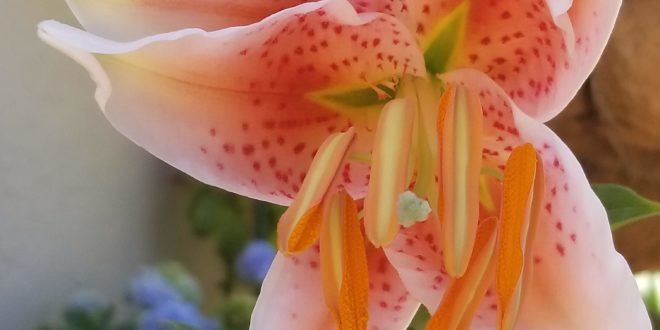Oriental lilies are a spectacular and perfumed addition to your summer garden. Growing oriental lily plants is easy with a well-prepared site for bulbs, plenty of sun and good drainage. Some of the most magnificent flowers in the lily family are in this large group of species and cultivars.
We originally bought a small bag of bulbs from Yamagami nursery in San Jose. Every few years we divide them and plant them in other pots in the garden.
Asiatic and Oriental are two of the most popular forms of true lilies available. True lilies are in the genus Lilium. They spring from bulbs with scales on the exterior and no protective skin. Asian lilies bloom in June to July while Oriental bulbs start to appear in August. Both are quite easy to grow with thick, rigid stems, strappy leaves and showy flowers. Oriental lily cultivars tend to have larger flowers. Orientals also thrive in cooler regions and can tolerate less than ideal soil conditions. Oriental lilies are larger than their Asian counterpart and very fragrant, making them popular additions to the cut flower garden. Many Oriental lilies may grow 3 to 6 feet (1-2 m.) in height, much taller than Asiatic lilies.
How to Grow Oriental Lilies
Site selection is the most important aspect when planting an Oriental lily. Choose a location that is in full sun when growing Oriental lily plants.
These bulbs cannot tolerate boggy soil, which means their planting bed should be tested for drainage and amended prior to installing the bulbs. Incorporate organic material into clay soils to increase drainage and nutrients. Oriental lilies are available either in fall or in spring. Install bulbs 4 to 6 inches (10-15 cm.) deep with the pointed part upward. Orientation is very important when planting an Oriental lily. Bulbs sprout and bloom the first year. Bulbs can withstand quite a bit of crowding and can be installed in containers too.
Oriental Lily Plant Care
Lilies are one of the easiest plants to care for. Once bulbs bloom, keep them moderately moist. When blooms are spent, cut off flower stalks but allow foliage to remain until yellow and beginning to die. This will help fuel the bulb for the next year’s bloom. In fall, mulch over the area with a few inches of organic bark mulch. Pull away in spring as soon as you begin to see sprouts. Fertilize bulbs once annually in spring with a good slow-release fertilizer. Once every 3 or so years, dig up the clusters of bulbs and divide them to increase plants and enhance flowers. If blooms are excessively large and begin to flop over, threatening the stem, simply stake them up until flowers are spent.








